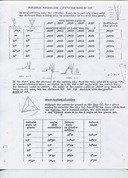The best recent literature on machine engraving is that associated with Jim Rimmer. His work and the work about him, however, is so generally useful that I've filed it not here but in ../ General Literature (Rimmer).
See also ../ General Literature (Legros & Grant) and ../ General Literature (Goudy).
For technical literature on specific engraving machines, see ../../../../ Typefounding, Lettering & Printing -> Pantograph Engraving Machines.
For studies of the uses of engraving machines (insofar as they are known), see various sections in: ../../ Making Matrices .

Mergenthaler Linotype (1930)
In 1930, the Mergenthaler Linotype Company published a large-format technical marketing document called Linotype Leadership extolling the advanced features of their machines. It's a lovely book, and a fine example of the genre. In it, they spent three pages discussing the process of "Making the Linotype Matrix." This shows their process for machine-engraving punches for mass-producing Linotype matrices. It omits many steps of the process, but the photographs are revealing and repay careful study.
The icon at left links to a PDF of scans I've done of just those three pages (35 Megabytes). Below are the images from it. These full-resolution images below (1200 dpi RGB PNG files) are quite large (the first, for example, is 125 Megabytes). You only want to click on them if you really need to study these images at the level of the halftone screen.

Anderson. "From Thought to Type." (2007)
Three articles by Mike Anderson in Galley Gab (2007) on machine engraving matrices and casting them on the Thompson. (The page linked here does not itself reprint these. Rather, it describes them and links to the online versions of them.)

Duensing? Pantograph Charts
These are four typescript sheets which were found with a photocopy of Paul Hayden Duensing's reprint of Nuernberger's Electrolytic Matrices (1966) . It is likely that they were distributed at a conference of the American Typecasting Fellowship. While no name appears on them, they are almost certainly by Paul Hayden Duensing. If indeed they are by Duensing, please note that Ginger Duensing has requested that Paul Hayden Duensing be identified as the author of all of his works. Thanks are due to Mark Knudsen (The Elmwood Press) for preserving these materials and making them available.
These sheets contain tables of cutter geometry and pantograph equipment for machine punchcutting:
Linotype Leadership was published in the US without copyright notice at a time when such notice was required to secure copyright. It therefore passed into the public domain upon initial publication. This digital reprint remains in the public domain.
Based on the material with which they were associated, the "Pantograph Charts" probably by Duensing were published without copyright notice at a time when such notice was required to secure copyright. Additionally, Ginger Duensing has granted permission for the reprinting here of Paul Hayden Duensing's works, provided that he always be credited with their authorship. Please respect her wishes and the memory of Paul Hayden Duensing and preserve the probable attribution of this material to him in any copies you make.
All portions of this document not noted otherwise are Copyright © 2011 by David M. MacMillan and Rollande Krandall.
Circuitous Root is a Registered Trademark of David M. MacMillan and Rollande Krandall.
This work is licensed under the Creative Commons "Attribution - ShareAlike" license. See http://creativecommons.org/licenses/by-sa/3.0/ for its terms.
Presented originally by Circuitous Root®
Select Resolution: 0 [other resolutions temporarily disabled due to lack of disk space]